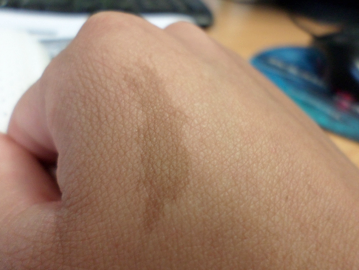Where does pigmentation come from?
A substance called melanin forms the pigment in our skin. Melanin is a complex polymer derived from the amino acid tyrosine found in melanocyte cells. Melanocyte cells are specialized cells distributed throughout the top layer of our skin (the epidermis). Once melanin is produced, it spreads to other skin cells nearby, giving a uniform color to our skin. Sometimes melanocyte cells can cluster in groups or “nests,” forming moles, freckles, age spots, and other skin discolorations.
In other instances, there can be too much, too little or no melanin present at all in the skin, leading to discolorations. Skin discolorations can also develop from abnormal groupings of blood vessels, funguses, and other aspects of our skin anatomy. Learn how to discover some of the most common types of skin pigment discoloration.
Common types of skin pigment discoloration
Lentigines
Lentigines sometimes referred to as liver or age spots, are flat, benign lesions, usually between 5-20 mm in diameter. These spots range in color from brown to black and typically arise in middle age from repeated sun exposure, also known as solar lentigines. However, not all lentigines occur with sun exposure.
Not to be confused with freckles, lentigines are more widely distributed, are generally darker in color and do not go away or fade during winter months as freckles do. Lentigines normally pose no risk, but they can sometimes be confused with melanomas. For this reason, you are advised to visit your doctor if you are concerned about a skin spot
Melasma
Melasma, sometimes also called chloasma, is a skin pigment discoloration condition where tan or brown patches appear on the body, typically on the face. , and for this reason, they frequently occur in pregnant women. Sometimes people even refer to melasma as “the mask of pregnancy.” Melasma can also be caused by contraceptives, hormone replacement therapy, and excessive sun exposure. While it’s more common in women, men can also suffer from melasma.
The increased amount of melanin in the skin that causes this type of skin pigment discoloration can occur in the epidermis (top layer of skin), dermis (middle layer of skin) or a combination of both. Melasma is not a dangerous condition, but it is one that can undoubtedly detract from the quality of life.
Luckily, there are treatments available, the most common of which is using a brightening cream with the ingredient hydroquinone.
Birthmarks
Birthmarks are colored spots on our skin that are usually present at birth. Sometimes these blemishes are red. When this is the case, they are a “vascular birthmark.” Abnormal blood vessels in the skin cause these types of birthmarks. The other main type of birthmark is called a “pigmented birthmark.”

This type of birthmark is present at birth and is usually brown, black or bluish-gray. Birthmarks typically suggest no major health risks, but if they are located in problematic areas, such as near a child’s eye, or create cosmetic concerns, they can be removed.
Hemangiomas
Hemangiomas are benign growths that form from the clumping of blood vessels. They usually appear on the skin or sometimes on internal organs, especially the liver. They are typically present at birth and rarely cause symptoms. Hemangiomas often resemble birthmarks and can range in color from port-wine to red-blue to salmon. Many types of hemangiomas may disappear by the age of 10. Other types that develop lesions or sores may require treatments ranging from medicated gel to surgical removal.
Seborrheic Dermatitis
Seborrheic dermatitis is a skin condition where a red, itchy, and scaly rash develops, typically on the scalp, but also in other areas of the body. It often looks similar to psoriasis, eczema or a rash from an allergic reaction. The rash isn’t contagious and can often remain on the skin for an extended period. Symptoms can include dandruff, greasy, and scaly skin, red skin or crusting, and sometimes itching or stinging. Although its exact cause is unknown, seborrheic dermatitis can be treated with creams, shampoos, ointments, and antifungal or other medications that affect the immune system.
Vitiligo
Vitiligo is a disease in which the skin forms white patches. It occurs when melanocyte cells stop producing melanin, either because they die off or simply stop functioning.
Causes of the condition are unclear, but it is thought to be an autoimmune disease. It can appear at any age and on any part of the body. Sometimes the white patches will spread throughout the body, while other times they will remain the same size. Vitiligo often first appears as a small, pale spot on the skin that, over time, will develop into a larger patch.

Vitiligo is generally harmless and it is not contagious, but its cosmetic appearance can cause emotional and psychological distress in people who suffer from it. There are several treatments that can help reduce the appearance of vitiligo, including corticosteroid creams, depigmentation treatments and UVA and UVB phototherapy.
Some of these treatments come with their own side effects, so it’s recommended to discuss options with a doctor.
Albinism
Albinism is an extreme form of skin pigment discoloration and more specifically hypopigmentation, that causes the partial or complete loss of pigmentation in the skin, hair, and eyes due to a lack or absence of tyrosinase, the enzyme essential in the production of melanin.
It occurs approximately in one in every 17,000 people worldwide and is a genetic disorder inherited at birth that affects all races.

There are different types of albinism with varying degrees of severity, resulting in a range of skin, hair, and eye pigments. Skin can be completely white, reddish-brown, or even normally colored. Hair and eye color also vary widely, depending on the type of albinism and degree of severity. Some rarer forms can cause life-threatening immune or neurological problems.
Regardless of the type of albinism, all affected people suffer from vision problems, including light sensitivities, misalignment issues, and poor vision. Albinism is an incurable condition that generally does not worsen over time. People with albinism are at an increased risk for skin cancer and should carefully protect themselves from the sun.
Negative social and emotional components of the disease are also common. While treatment is limited, genetic counseling, proper eye care, and vigilant monitoring of the skin for signs of skin cancer are recommended.
Skin cancer symptoms: what to look out for
Tinea Versicolor
Tinea Versicolor is a condition that occurs when a natural yeast found on the skin called pityrosporum ovale grows out of control and begins to change the pigmentation of the skin. When this occurs, patches of skin may become lighter or darker. Tinea versicolor can be caused by a variety of factors including hot weather, oily skin, a weakened immune system, hormonal changes and excessive sweating.
This condition is more common in adolescents and young adults, frequently occurring in adults when they visit warm and humid climates. Tinea versicolor can typically be treated with over-the-counter anti-fungal medications, which are often effective in removing the discolored patches or spots.

If these medications don’t work, it is advised to contact your doctor for further tests to confirm it is tinea versicolor. A doctor may prescribe a topical cream or prescription pills to treat the condition. Many people are able to eliminate the infection entirely, but the skin may remain discolored for some time after, ranging from weeks to months.
The condition can sometimes also flare back up, especially if the patient returns to a warm environment or switches hormonal medications.
Lichen sclerosus
Lichen sclerosus is a rare condition that creates thin patches of white skin. It is a long-term condition that usually affects the skin of the genitals. It is common in women who have gone through menopause, but men and children can also be affected.
Common symptoms include smooth white spots on the skin, white patches that join together and become cracked or sore, itchiness, fragile skin, wrinkly or thickened skin, blisters, and pain when having sex or going to the bathroom.
While the cause of lichen sclerosus is unknown, hormonal imbalances are a suspected factor as well as an overactive immune system. It is not contagious and cannot be spread through intercourse. There’s currently no cure to the condition but symptoms can be managed with the use of steroid creams and ointments.
When used correctly, the creams usually help ease or alleviate symptoms entirely.
Eczema
Eczema, also known as atopic dermatitis, is a type of skin pigment discoloration that causes red, itchy and dry skin as a result of inflammation. Sometimes white patches or spots can form within a red rash. This condition is typically found in children but can continue into adulthood.
Eczema symptoms include dry, scaly, thickened skin that is almost always itchy. Especially among darker-skinned people, eczema can cause skin discoloration, making the affected area lighter or darker than the surrounding skin.
The cause of eczema is unknown but it is thought to be linked to allergies and asthma and is suspected to be an overactive immune response to an irritant. While there is no cure for the condition, symptoms can be managed. For many people, eczema will even go away over time. Doctors can prescribe topical corticosteroid creams and ointments, oral medications and light therapy to help ease symptoms.
Pityriasis alba
Pityriasis alba is a skin disorder commonly found in children and young adults that causes pale pink or red, scaly patches to form on the skin. When these patches clear up, the skin is left discolored, with smooth light patches taking their place. Lesions can be round, oval or irregular in shape and many patches can occur at once, especially on the face and arms.
The condition is believed to be associated with eczema and, as such, an overactive immune response is a suspected cause.

Patches may clear up within a few months or, in some cases, can last for several years. No treatment is required for pityriasis alba as the patches usually go away over time, with most cases disappearing by adulthood.
However, a doctor will often prescribe a steroid or non-steroid cream to ease the dryness, and/or itching. In some cases, the patches can flare-up in the future and require further treatment.
Idiopathic guttate hypomelanosis
Idiopathic guttate hypomelanosis is a disorder that causes 1 to 10 mm flat white spots to occur, typically on the shins, arms upper back and face. It is usually found in fair-skinned individuals but can also occur in dark-skin. While the exact cause is unknown, they often begin to form as a person ages, usually appearing in those 40 years or older.

The spots are benign (not harmful) and are thought to be brought on by sun exposure, which kills melanocyte cells in the skin. No treatment is usually needed but preventative measures to block against sun damage should be taken. Topical steroids, creams, and dermabrasion can be used to minimize the appearance of the spots.
Read More: Early melanoma symptoms and how to spot them
This is by no means an exhaustive list of disorders and conditions that can result in skin pigment discoloration, but rather a list that helps you familiarize yourself with some of the most common forms of discoloration.
SkinVision helps you check your skin for signs of skin cancer with instant results, right on your phone. Our clinically-proven technology, combined with the knowledge of dermatologists specialized in skin cancer, helps you keep your skin healthy.


















